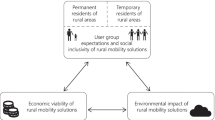Abstract
Global demand for (individual) mobility and motorization is increasing rapidly. Mobility is important to economic and social development, especially in urban centers (Döhmel 2008). But mobility is also considered a main reason for accelerating climate change in the form of CO2 emissions (IPCC 2007). Politicians, media, NGOs and (city) governments identify mobility as a core domain to design and launch strategies and measures mitigating climate change in urban centers. In recent years, strategies and measures incorporated were often less effective because customer needs and demands were not met sufficiently and the costs of (individual) mobility were increased by regulations and taxation. The leading idea of this paper is to design a conceptual framework, whereby open innovation approaches and pricing as key elements are applied to customer-focused strategies and measures mitigating climate change in urban centers.
Access this chapter
Tax calculation will be finalised at checkout
Purchases are for personal use only
Similar content being viewed by others
References
ADL (2009) Zukunft der Mobilität 2020. Arthur D. Little
Archaya VV, Pedersen L, Philippon T, Richardson M (2011) Taxing systemic risk. In: Archaya VV, Cooley TF, Richardson M, Walter I (eds) Regulating wall street. Wiley, Hoboken, pp 121–142
Beckert J (2011) Where do prices come from? Sociological approaches to price formation. Discussion Paper 11/3, Max Planck Institute for the Study of Societies, Cologne, pp 1–26
Bellmann K (1990) Langfristige Gebrauchsgüter: ökologische Optimierung der Nutzungsdauer. Deutscher Universitäts-Verlag, Wiesbaden
Chesborough HW (2003) The era of open innovation. MIT Sloan Management Review, Spring, pp 35–41
City of Seattle (2012) Share your ideas for a better Seattle, Seattle City Council. Retrieved on Sept 21 from http://seattlecitycouncil.ideascale.com/a/ideafactory.do
Dichtl E, Peters S (1996) Kundenzufriedenheit und Kundenbindung in der Automobilindustrie: Ergebnisse einer empirischen Untersuchung. Bauer HH, Dichtl E, Herrmann A (eds) Automobilmarktforschung: Nutzenorientierung von PKW-Herstellern, Verlag Franz Vahlen, München, pp 15–31
Döhmel K (2008) Future mobility from a fuels perspective. In: 29th Vienna Motor symposium 24–25 April 2008, VDI Verlag, Düsseldorf, pp 25–39
Florida R (2005) Cities and the creative class. Routledge, Abingdon
Füller S (2006) Wie läßt sich das innovative Potential von Online-Communities nutzen?—Vorstellung der Etnographie-Methode, Institut für Strategisches Management, Marketing und Tourismus, Universität Innsbruck/Austria, n.p
Hilmola O-P (2011) Benchmarking efficiency of public passenger transport in larger cities. Benchmarking 18(1):23–41
Hippel Ev (2005) Democratizing innovation. MIT Press, Cambridge
Intergovernmental Panel on Climate Change IPCC (2007) Working group III, 4th Assessment, summary for policymakers, pp1-23
Kaiser M, Kürzinger J (1994) Handlungsbedarf und Forderungen für eine nachhaltige Entwicklung der Erde, Verband Weihenstephaner Forstingenieure (eds) Waldökosysteme im globalen Klimawandel, pp 107–114
KPMG (2012) Global automotive executive survey, pp 1–57
Krugman PR (1991) Increasing returns and economic geography. J Polit Econ 99(3):484–499
Lancaster KJ (1966) A new approach to customer theory. J Polit Econ 75:132–157
Lilien GL, Morrison PD, Searls K, Sonnack M, Hippel Ev (2002) Performance assessment of the lead user idea-generation process for new product development. Manage Sci 48(8):1042–1059
Liu Z, Geng Y, Xue B (2011) Inventorying energy-related CO2 for City: Shanghai Study. Energy Procedia 5:2303–2307
McDermott P (2010) Building open government. Gov Inf Q 27:401–413
Mildenberger U, Khare A (2000) Planning for an environment-friendly car. Technovation 20:205–214
Nam T (2012) Suggesting framework of citizen-sourcing via government 2.0. Gov Inf Q 29:12–30
Pénin J, Hussler C, Burger-Helmchen T (2011) New shapes and new stakes: a portrait of open innovation as a promising phenomenon. J Innovation Econ 7(1):11–29
Sternlieb G, Hughes JW (1988) New York City. In: Dogan M, Kasarda JD (eds) Mega-Cities, Sage Publications, Newbury Park et. al., pp. 27–55
Taylor WB (1981) The use of life cycle costing in acquiring physical assets. Long Range Plan 14(6):32–43
Tiwari G (2003) Transport and land-use policies in Delhi. Bull World Health Organ 81(6):444–450
Tributsch, H. (2008). Nachhaltige Energienutzung, Stiftung Brandenburger Tor (ed), Prototypen. Bionik und der Blick auf die Natur, pp 46–48
UN (2006) World urbanization prospects: the 2005 revision, New York
Van der Ploeg F, Poelhekke S (2008) Globalization and the rise of megacities in the developing world. CESifo working paper, No 2208, München
Weidlich W, Haag G (eds) (1999) An integrated model of transport and urban evolution with an application to a metropole of an emerging nation. Springer, Heidelberg
Wittmann J (1998) Target project budgeting. Deutscher Universitäts-Verlag, Wiesbaden
Wittmann J (2008) Target value pricing im Produktentstehungsprozess innovationsorientierter Unternehmen—ein konzeptioneller Ansatz. Himpel F, Kaluza B, Wittmann J (eds) Spektrum des Produktions- und Innovationsmanagements, Gabler Edition Wissenschaft, Wiesbaden, pp 215–224
Wübker G (2005) Optimierung der Pricing-Prozesse: Der Weg aus der Ertragskrise. Thexis 21(3):29–35
Author information
Authors and Affiliations
Corresponding author
Editor information
Editors and Affiliations
Appendix 1
Appendix 1
Cost-benefit scenarios of vehicles of two owner’s life-cycles with different gas consumption rates (virtual example) 
Rights and permissions
Copyright information
© 2013 Springer-Verlag Berlin Heidelberg
About this chapter
Cite this chapter
Wittmann, J. (2013). Mobility and Mitigating Climate Change in Urban Centers: Open Innovation and Pricing as Key Elements for Customer-Focused Strategies and Measures. In: Khare, A., Beckman, T. (eds) Mitigating Climate Change. Springer Environmental Science and Engineering. Springer, Berlin, Heidelberg. https://doi.org/10.1007/978-3-642-37030-4_7
Download citation
DOI: https://doi.org/10.1007/978-3-642-37030-4_7
Published:
Publisher Name: Springer, Berlin, Heidelberg
Print ISBN: 978-3-642-37029-8
Online ISBN: 978-3-642-37030-4
eBook Packages: Earth and Environmental ScienceEarth and Environmental Science (R0)




